NCAC NEWS(Vol.7,No.2)
Personal Computer Network SEIKATSU-New Net Made Public
National Consumer Affairs Center of Japan (NCAC) began accepting members in June 1995 for SEIKATSU-New Net, its personal computer network focused on living information for consumers. SEIKATSU-New Net has two main services: database services which provides easily searched consumer data collected by NCAC, and communication services through which members will be able to exchange information.
In terms of the database services, users can obtain product test results accumulated by NCAC, analytical information obtained from consumer counseling cases, information on product accidents, useful knowledge for living, and reference materials kept by NCAC. There is an information search function to enable users to access the specific information they need quickly.
SEIKATSU-New Net provides both text and graphics information (See photograph.). In order to use this graphic information, a communication software which can handle graphic information is necessary.
The Information service in SEIKATSU-New Net is presently provided only in Japanese.
Starting on October 1 of this year, we set up a NCAC Home Page on Internet (with both English and Japanese versions) (http://www.kokusen.go.jp/).
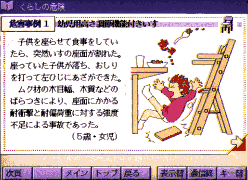
Daily Life Picture Book, "Danger! Take care!"
Unexpected Hazards in Leisure Area. User Burned by Lighter Agent.
1. What Is Jelly-like Lighter?
Jelly-like Lighter is a soft, transparent agent (either colorless or pink) in a polyethylene container that serves as a supplementary fuel. When users want to barbecue or go camping and need to ignite fuel (such as firewood or charcoal), they use this lighter agent to start a fire easily with just a match.
The main ingredient of this lighter agent is methanol, which is designated as a dangerous chemical under the Law for Control of Poisonous and Powerful Agents. This lighter agent is classified as a hazardous substance under the Fire Service Law. (Type 2 Hazardous Substance: an ignitable solid posing Class III hazard, the lowest level).
2. Accidents When Adding to a Fire
- [Case 1]
- When I went camping and tried to light firewood with the lighter agent, it did not ignite well. When I added more of the agent, bits of it flew off and stuck on my face and hand, burning me. I received treatment for two weeks, but I still have scars. (July 1993, a woman in her 20s)
- [Case 2]
- I wanted to have a barbecue in the garden. I used the lighter agent to start a charcoal fire. It did not seem as if the fire was starting, so I held the container above the charcoal and pushed out the material. The igniting agent flew off, and bits of it got on the face of my child, who was close by. My child, a three-year old boy, suffered second and third-degree burns near the right eyebrow and left temple. (May 1994)
3. Investigation Findings
NCAC investigated four brands of lighter agents produced by three companies, and all of them carried the safety indications required by the Fire Service Law (product name, hazard level, "Flammable," etc.)
Other information provided by specific companies is described below: Company A: There is the warning "Adding to a burning fire is strictly prohibited," but there is no specific description of what might happen if lighter agent is added to a burning fire.
Companies B and C: Information is printed on the cellophane bag that covers the container, but there is no information on the container itself. There are warnings: "Adding more agent to a burning fire is strictly prohibited" and "Use caution when starting because this is a flammable substance." There is a warning regarding the danger of burns.
4. Cause of Accidents
To investigate what happens when the lighter agent is added to a burning fire, NCAC tried to reproduce accidents in the laboratory. We were able to determine the cause of the flying off and scattering of bits of the material when added to a burning fire as follows:
- The main ingredient of the igniting agent, methanol, is highly volatile and it evaporates easily. As a result, a mixture of methanol and air builds up in the container.
- When lighter agent is added, the container is held above a small fire or burning kindling. The gas mixture in the container expands because it is heated.
- The container is pointed downward while in use. Since the outlet hole becomes blocked with the lighter agent, the pressure of the gas mixture inside rises.
- When the pressure inside exceeds a certain point, the gas mixture pushes through the lighter agent and is suddenly discharged from the container. This serves to ignite the lighter agent that is pushed out.
- The gas mixture is also ignited, and the flame spreads accompanied by the sound of an explosion. At this point, the lighter agent inside the container flies from the container as it burns. (See photograph.)
(i)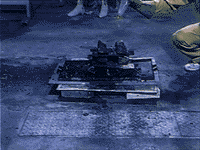 (ii)
(ii)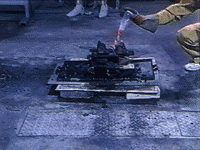
(iv)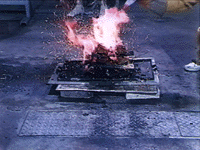 (iii)
(iii)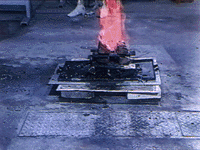
When there is a large amount of the agent in the container, even when the pressure inside rises, it does not get to the point of pushing it outside of the container because there is little empty space. For this reason, the possibility of igniting the gas mixture and of an explosion is small in these circumstances.
Causes of explosions not related to adding lighter agent to a burning fire were determined to be as follows: Because the vapor from methanol is a little heavier than air, it tends to produce a volatile gas mixture around the fuel. When a source of flame ignites this gas mixture, an explosion results that scatters the lighter agent.
5. Request to makers
- Methanol, the main material, is an extremely flammable substance with a combustion point of only 11°C Considering that this is a product for consumers who do not have any knowledge of chemicals, the product itself should be improved so that it will not be dangerous.
- When the lighter agent is squeezed from the polyethylene container, the container returns to its original shape by taking in air, which makes it easier for an explosive gas mixture to build up. Also, when the container is squeezed, the gas mixture is expelled from the container. We ask the makers to improve the container's structure so that it will not allow an empty space to be formed.
- Makers must have clearer labeling so that accidents will be prevented.
- Instead of the warning "Adding to a burning fire is prohibited," there should be a clear warning about the danger, such as, "If you add this substance to a burning fire, the lighter agent will fly off and may burn you."
- Because flame is often difficult to see in a lighted area, there should be a warning that it is dangerous to hold your hands close to the flame.
- There should be clear instructions as to what to do when an accident occurs.
- There should be a warning label on accidents due to causes other than adding the agent to a burning fire.
- The markings and warnings should be on the container itself rather than on the outer bag, which may be thrown away. The label and markings on the container should be not peel off or become illegible during normal use.
6. Advice to Consumers
- The lighter agent is a flammable and dangerous product. Using it improperly can lead to serious accidents, so handling instructions and cautions should be observed fully.
- Once you light the fire, never add on more lighter agent.
- Because the main ingredient, methanol, is highly toxic, you can be poisoned by breathing the vapors. Therefore, do not use this product in a poorly ventilated location. If any of this substance gets in your mouth, spit it out immediately. See a doctor promptly if symptoms persist. If any of the lighter agent gets on your skin, the methanol may be absorbed. Therefore, wash it off right away.
- Responses to accidents during camping trips and other outdoor activities tend to be taken later than for accidents at home. Therefore, take extra care when using this product.
Users Drank Juice, But It Turned Out To Be Liquor!
- [Case 1]
- "A 70-year old man with no tolerance for alcohol drank a beverage with a familiar trademark that was actually an alcoholic beverage. He suffered acute alcohol poisoning, requiring four days of hospitalization." (August 1994)
- [Case 2]
- "Sixth-grade boy drank an alcoholic beverage that was in the refrigerator thinking that it was a soft drink. His body became red, and he had a severe headache. This caused his parents to become deeply concerned." (June 1995)
1. Alcoholic Beverages That Can Be Inadvertently Consumed.
The soft drink in question was released in May 1993, and the alcoholic beverage was released in February 1994. At the time that the alcoholic beverage was released, the label on the can stated that "This is alcoholic beverage." However, accidents such as those described above ocurred because some people mistook the alcoholic beverage for the soft drink. Because of the appearance of a famous actress in its TV commercials, and the boom in low-alcohol beverages, sales of this product have been increasing. In fiscal 1994, 150 million cans of the soft drink and about 45 million cans of the alcoholic drink were sold.
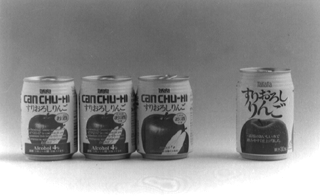
Softdrink(right) and 3 Alcoholic beverages
(from right to left in order of production)
2. Maker's Response Measures
In autumn of 1994, the maker enlarged the characters in the label "This is an alcoholic beverage." Also, English words on top of the illustration of an apple on the can emphasized the alcoholic image. In June 1995, the chinese character for liquor was provided with phonetic reading in kana (so that even children can read it). Also, the company embossed the words "This is an alcoholic beverage" near the can's ring-pull and wrote it in Braille as well. Since this July, all cans of the alcoholic beverage have this new labeling. While considerable ingenuity has been shown in making these changes, the designs of the soft drink and the alcoholic beverage are still quite similar.
3. Problems
For one thing, both the soft drink and alcoholic beverage have the same name, and the basic design of the apple on the white background is extremely similar. Even with the English words, we believe that there will be many people who will not be able to tell the difference. (Case 2 occurred with a can design where the maker sought to emphasize the alcohol-like character.) This is particularly true for customers who buy it from vending machines, where most consumers just look at the color and drawing on the product.
Also, the alcoholic beverage can has "CAN CHU-HI" (meaning that it is a cocktail with a shochu spirits base) above the picture of an apple, but it is hard for a child or elderly person to understand the meaning of this. In particular, children tend to make snap judgments by just looking at the design and color and simply drink it without bothering to read the labeling. Needless to say, the law prohibits minors from drinking alcoholic beverages. Depending upon the amount, drinking alcoholic beverages can easily lead to an accident.
4. Advice to Consumers
When you buy a drink, check to see if it is a soft drink or alcoholic beverage before you drink it. In households with children, teach children how to distinguish soft drinks from alcoholic beverage, so that they will inadvertently drink alcoholic beverage.
5. Maker's Response Afterwards
This September, the maker announced that starting with mid-November shipments, the product name and design will be changed. This change was made in response to criticisms and requests brought to its attention by NCAC and consumer groups.
Results of Product Tests of Home Electronic Blood Pressure Monitors
Because of greater the awareness of the need to manage our own health, it has been reported that sales of home blood pressure monitors are increasing. There are new products that can take your blood pressure by measuring on the fingertip or wrist. Here we provide information on the accuracy and ease of use of a number of home blood pressure monitors (four brands for use on the upper arm, one for use on the wrist, one for use on the fingertip, and one which is a wrist-watch type), as well as ideas on effectively using these pruducts in the home.
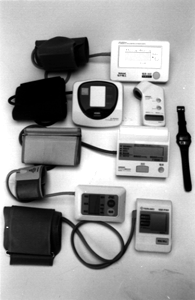
1.Performance
Normally, doctors use a device with a mercury column called a sphygmomanometer to measure blood pressure (the Korotokoff method). Most of the electronic blood pressure monitors tested use this osillometric method. With regard to accuracy, when we compared the readings of the mercury-type blood pressure monitors, the upper-arm type showed only a small difference with the mercury-type. On the other hand, the fingertip-type, wrist-type, and wrist-watch type showed relatively large differences in readings compared to the upper-arm type. However, the purpose of blood pressure monitors is to take readings each day, and to observe the trend. From this perspective, the differences in readings among the brands that we tested are not excessive. As long as they are used carefully ane correctly, these products should not pose any serious problem.
With regard to the life of the battery, even the shortest-lived was good for 300 measurements. Assuming that the user takes two readings a day, even the shortest-lived can be used for about five months, which is fairly long.
2.Ease of use
With the upper-arm type, you need to roll up your sleeve to put on the cuff. The fingertip-type and wrist-type do not require rolling up the sleeve, so they are easier to use.
Before using the wristwatch-type, you need to input your blood pressure. (previously taken with an upper-arm-type.) Inputing this number is rather difficult, and when someone else wants to use the same device, new individual data must be input.
Also, there were some differences in the legibility of product labeling, readings, and handling instructions.
3.Advice to consumers
Based on volunteers who tested monitors, blood pressure differs according to the time of measurement, so it is important to take readings everyday and under the same conditions.
It is also important to take measurements at the same level as the heart. The upper-arm type is always at the same level as the heart due to its design, but with the fingertip, wrist- and wristwatch-type, the readings can vary with the position. Therefore, it is important to keep the divice at the correct height when using it.
